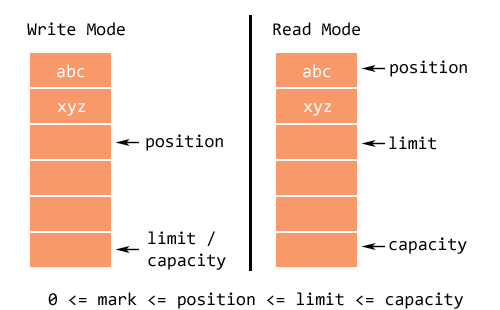ByteBuffer 在NIO的作用
Java SE4 开始引入Java NIO,相比较于老的IO,更加依赖底层实现。引入通道(Channels),选择器(selector),缓冲(Buffers).都更加接近操作系统执行I/O的方式.所以速度更快。
NIO 是非阻塞IO,非阻塞IO的实现是基于事件的,选择器定义了一个IO通道,程序继续运行。选择器上发生事件时,会唤醒选择器并执行相应动作。IO是阻塞IO,面向流操作,顺序读写,对于小文件序列化的读写有优势。nio是面向缓冲器,对数据的偏移支持比较好。
本文提到的ByteBuffer就是缓冲器,负责与通道进行数据交换。缓冲器总共有ByteBuffer,CharBuffer,DoubleBuffer,FloatBuffer,IntBuffer,LongBuffer,ShortBuffer.
ByteBuffer的重要属性
Buffer 基类
属性
缓冲器都继承了Buffer类,Buffer是一个固定大小的数据容器。除了存储内容之外,还有三个重要的属性。
capacity buffer中元素总数
position 写模式下就是下一个元素的index,读模式就是当前元素index
limit 是不应该被读/写的第一个元素index。写模式时就是capacity,读模式则是下一个元素的index.如下图:图片来自http://javapapers.com/java/java-nio-buffer/
方法
- flip
一般是切换到读操作。或者是为写操作准备一个新的序列
public final Buffer flip() {
limit = position;
position = 0;
mark = -1;
return this;
}eg.重复向一个ByteBuffer写数据的时候,赋值完毕,必须要flip.开始一个新的新序列,否则position会等于limit,返回空值
public static void main(String[] args) {
byte[] bytes1=new byte[]{1, 6, 3};
ByteBuffer buffer =fromByteArray(bytes1);
System.out.println(buffer);
byte[] bytes2 =new byte[]{1,2,3};
ByteBuffer buffer2=fromByteArray(bytes2);
System.out.println(buffer2);
}
/**
* If you are building up a ByteBuffer by repeatedly writing into it, and then want to give it away, you must remember to flip() it.
* If we did not flip() it, the returned ByteBuffer would be empty because the position would be equal to the limit.
* @param bytes
* @return
*/
public static ByteBuffer fromByteArray(byte[] bytes) {
final ByteBuffer ret = ByteBuffer.wrap(new byte[bytes.length]);
ret.put(bytes);
ret.flip();
return ret;
} - rewind
rewind倒回,将position 设置为0,重新读取
public final Buffer rewind() {
position = 0;
mark = -1;
return this;
}- clear
clear 并没有真正的清除数据,将position设置为0,limit设置为capacity.
public final Buffer clear() {
position = 0;
limit = capacity;
mark = -1;
return this;
}ByteBuffer
ByteBuffer 相比较其他的缓冲器有些区别
可以分配直接缓冲区
直接缓冲区,JVM会尽可能的直接在此缓冲区执行本机IO操作。避免与中间缓冲区交互可以通过mapping将文件区域直接映射到内存来创建、
访问二进制数据
参考
http://www.javaworld.com/article/2078654/java-se/java-se-five-ways-to-maximize-java-nio-and-nio-2.html
http://javapapers.com/java/java-nio-buffer/
https://docs.oracle.com/javase/7/docs/api/java/nio/package-summary.html#buffers






















 925
925

 被折叠的 条评论
为什么被折叠?
被折叠的 条评论
为什么被折叠?








